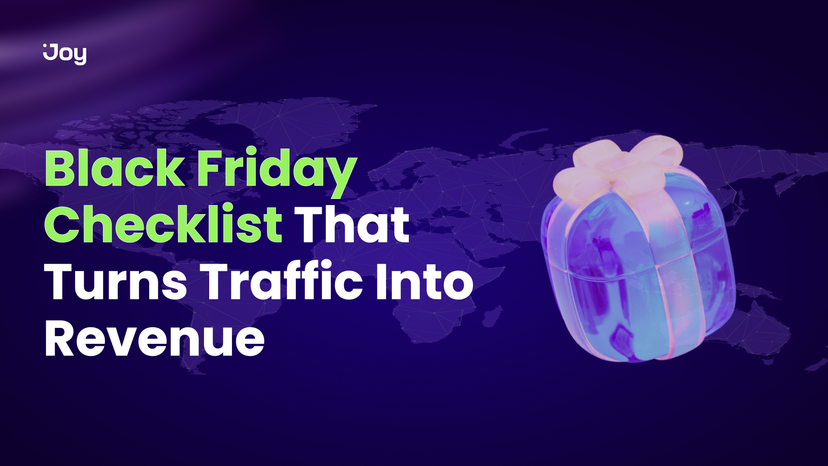If you run a business, you’ve probably heard of loyalty and referral programs. Many business owners say that referral programs have made a huge difference for them. Others say that building customer loyalty has been the key to their success.
So, you might be wondering: What’s the difference between these two types of programs? Can I use both for my business?
This article will answer those questions!
Understanding Loyalty Programs
A loyalty program is a system designed to reward your customers for their repeat business. Its primary goal is simple: to encourage customers to shop with you again and again. At the same time, it helps you build a deeper connection with them and increase their lifetime value.
Here’s how it works:
- Customers earn points for specific actions—like making a purchase or signing up for your newsletter.
- These points can then be redeemed for rewards, such as discounts, free products, or exclusive perks.
Starbucks Rewards is a standout example of a loyalty program in action. Customers earn “stars” with every purchase, which can be redeemed for free drinks and food.
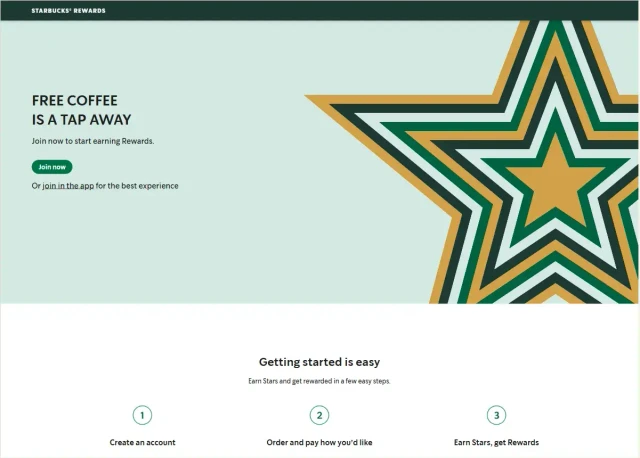
Of course, loyalty programs can be much more sophisticated than that. They can involve points, tiers, exclusive perks, and personalized rewards. But the basic principle is the same: reward your customers for their loyalty, and they’ll reward you with their repeat business.
Understanding Referral Programs
A referral program is a system that encourages your existing customers to refer their friends, family, or colleagues to your business. The main goal of a referral program is to leverage the trust and influence customers have with their connections to gain new customers, and in return, they get rewarded.
How does it work?
- Customers receive unique referral codes or links, which they can share with others.
- People who receive the link complete a specific action on your store, such as making a purchase.
- Both your customer and the referred friend receive a reward.
Dropbox’s referral program is running its referral program so well. It rewarded both referrers and referees with additional free storage space for each successful referral.

A referral program is one of the most cost-effective ways to attract new customers while keeping your existing ones engaged.
Loyalty and Referral Program: Key Differences
Here’s a breakdown of their key differences:
| Aspect | Loyalty Program | Referral Program |
|---|---|---|
| Purpose | To retain and reward existing customers for their loyalty. | To attract new customers through referrals by existing customers. |
| Target Audience | Existing customers. | Existing customers and their network (potential customers). |
| Incentive Type | Encourages continued spending or engagement. | Encourages spreading the brand to others. |
| Reward Criteria | Based on repeat purchases, engagement, or accumulated points. | Based on successful referrals or conversions. |
| Common Rewards | Discounts, free products, early access, or loyalty points. | Cash rewards, discounts, free products, or credits for both referrer and referee. |
| Implementation | Often includes a loyalty point system or tiered benefits. | Requires tracking referral links, codes, or unique identifiers. |
| Timeframe | Long-term and ongoing. | Typically event-driven or campaign-specific. |
How To Choose Between Referral And Loyalty Programs
Selecting the right program depends on your business goals, target audience, and resources. Here’s a detailed guide to help you decide:
- Understand Your Goals:
- If your focus is on attracting new customers, go with a referral program.
- If your goal is to retain current customers and encourage repeat purchases, a loyalty program is your best bet.
- Know Your Customer Base:
- If you already have a solid base of engaged customers, go for a referral program.
- If you’re a new business or need to strengthen customer relationships, focus on building a compelling loyalty program first to create a base of loyal customers.
- Assess Budget and Resources:
- Referral programs are typically cost-effective, with rewards linked to successful referrals.
- Loyalty programs require an investment in systems to track and reward customer loyalty effectively.
- Evaluate Industry Fit:
- Referral programs work best in industries for brands with high-ticket items or niche products, such as Saas, jewelry, or subscription services
- Loyalty programs are popular for stores selling everyday essentials or frequent-purchase items like retail, hospitality, and food services.
Can Loyalty and Referral Programs Work Together?
Yes, many businesses successfully use both loyalty and referral programs, and they succeed! Loyalty and referral programs can work hand in hand to create a powerful, continuous cycle of growth:
- Attract: A customer discovers your brand and makes their first purchase.
- Engage: They join your loyalty program and start earning rewards.
- Retain: They become a repeat customer, enjoying the benefits of your loyalty program.
- Refer: They’re so happy with your brand that they refer their friends.
- Acquire: Their friends become new customers, and the cycle starts again!

If you sell something that people buy often and you’re in a competitive market, running both loyalty and referral programs can be beneficial. Consider using a points-based system or offering different types of rewards. This keeps both programs interesting and encourages customers to participate in both.
Running Loyalty and Referral Program Together: A Real-Life Example
Let’s take a look at a real-life example of a brand that successfully runs loyalty and referral programs together: Korean Skincare. Leveraging Joy Loyalty Program, it has created a dynamic rewards system to engage its customers and drive growth.

The referral program is seamlessly integrated into the KS Glowie Club loyalty program. Referring friends is one of the actions that earn customers glow points, which contribute to both rewards and tier progression. It encourages loyal customers to actively share the brand with others to earn more rewards.
Customers can move up the loyalty ladder to enjoy more perks and redeem their earned points for discounts or free products.
How to Implement A Loyalty – Referral Program For Your Shopify Store
Running a loyalty-referral program for your Shopify store is easier than you think. Let me guide you through the key steps to set up a program that boosts customer retention and attracts new customers.
Step 1: Define Your Goals and Objectives
Start by identifying what you want to achieve:
- Are you looking to increase repeat purchases?
- Or do you want to expand your customer base?
- Maybe both?
Defining clear goals will help you design a program that aligns with your business needs. For example, if your goal is customer retention, focus on rewarding loyalty. If it’s customer acquisition, emphasize referrals.
Step 2: Choose the Right Shopify App That Offers Both Features
Next, pick an app or service that supports loyalty and referral features. Here are a few great options:
- Joy Rewards & Loyalty Program: Joy offers an easy-to-use interface to create custom loyalty and referral programs. It integrates seamlessly with your online store, allowing you to set up point systems, deliver discounts, and track rewards effortlessly
- Smile.io: This app specializes in creating loyalty points, referral programs, and VIP tiers. It’s user-friendly and provides great customization options for rewards and branding.
- ReferralCandy: Focused primarily on referral programs, ReferralCandy allows you to reward customers for bringing in new shoppers. It also supports integrations with loyalty programs.
- LoyaltyLion: An all-in-one app for loyalty programs, LoyaltyLion helps you design personalized reward structures and integrate email marketing campaigns.
- Rise.ai: Ideal for gift cards and store credit-based loyalty programs, Rise.ai also includes referral features that help you build customer trust.
When selecting an app, evaluate its features, pricing, and compatibility with your business size and goals.
Step 3: Design Your Loyalty – Referral Program Structure
This step is crucial. Decide on the program rules, actions, and rewards. Think about:
- Loyalty Actions: What will you reward customers for?
- Referral Rewards: Will you reward both the referrer and the new customer?
- Redemption Options: Points for discounts, free products, or tier upgrades. Keep it simple and attractive to customers.
I’ll demonstrate the process using Joy Loyalty on a Shopify store:
Design Loyalty Program structure – Earning programs: Define how customers earn points. For a loyalty program, focus on activities like purchases, leaving reviews, or signing up for your newsletter.
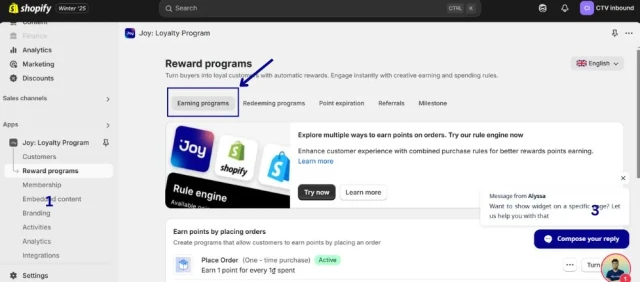
From the admin dashboard, access Apps > Joy: Loyalty Program > Reward programs
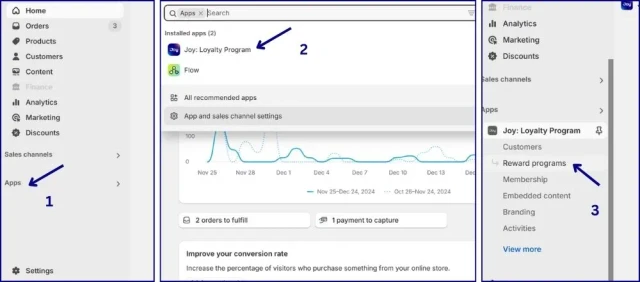
- Determine rewards redeemed from points such as discounts, free products, or exclusive access to sales in the Redeeming programs.
You can introduce tiers (e.g., Bronze, Silver, Gold) to incentivize higher spending. Access Membership > VIP Tier > Set Up.
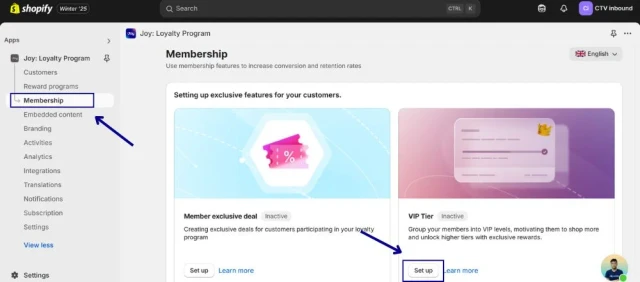
- You should offer rewards for both referrers and referees. From my experience, double-sided rewards often get a much higher participation rate. Click the pencil icon to set up rewards for the referrers and referees.
Design Referral Program on the Referrals. You should reward customers when they successfully invite their friends to shop at your store.

- Ensure the rules are clear, fair, and easy to understand. Remember to click Save to enable it on your store.
Limit the program to prevent abuse (e.g., one reward per referred customer).
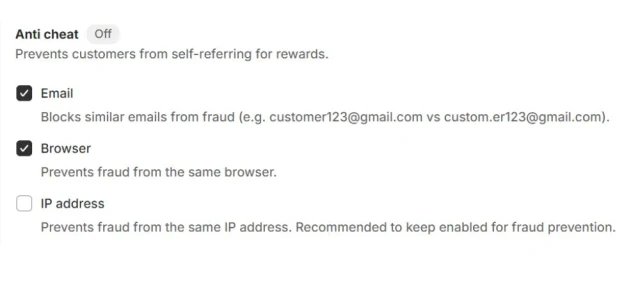
Design an Engaging User Interface on Your Shopify Store
Your loyalty referral program’s visibility and user experience will influence customer participation. You should make it visible on your store by:
- Creating a dedicated page that explains the program, showcases rewards, and includes a sign-up form.
- Using eye-catching pop-ups, banners, or a floating widget to catch attention.
- Including links in email newsletters, social media, and other communication channels.
If you’re using Joy Loyalty, it is so easy to design and launch a beautiful, branded loyalty referral program, whether you want it to be a page or a floating widget. Here, I’ll walk you through some simple steps to design your floating widget:
- Step 1: Open the Joy app and navigate to Branding
- Step 4: Preview your design on the right side and Click Save to activate it.
Step 3: Add your own color palette, set up icon theme, button, etc.
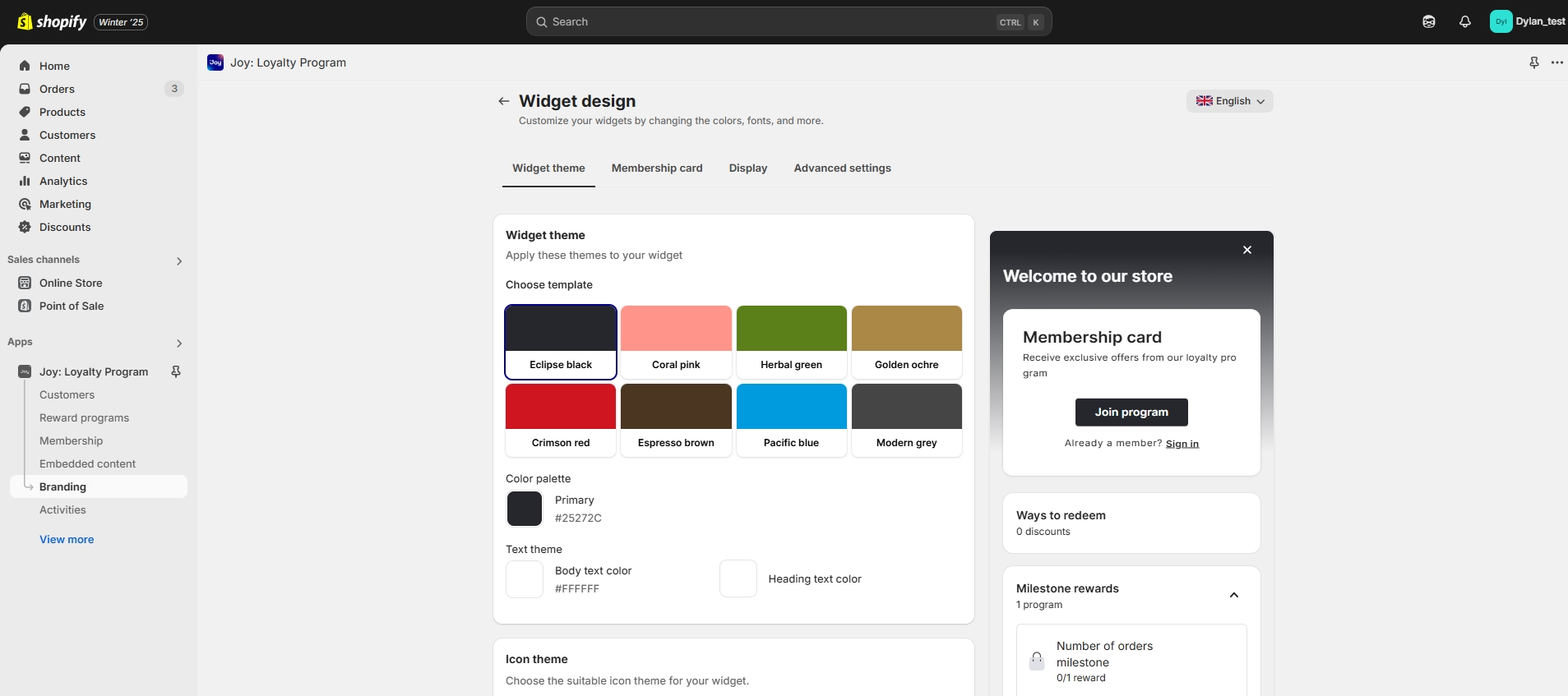
Step 2: In the Widget design block, click Set up
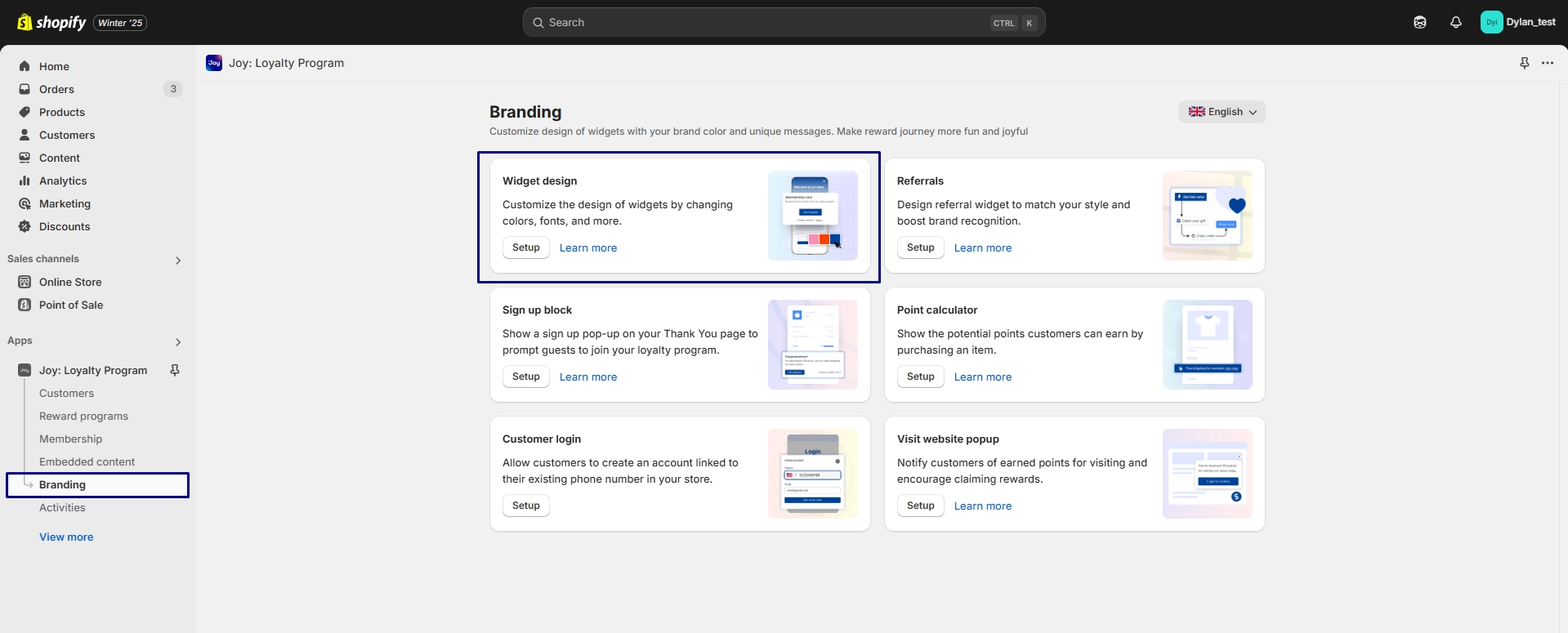
If you want to create a stunning loyalty referral dedicated landing page, visit our reward page design article and scroll to the bottom of the article for step-by-step instructions tailored just for you!
Promote Your Program
Letting customers know about your loyalty-referral program is crucial for adoption. Use multiple channels to spread the word:
- Email Marketing: Announce the program and send periodic reminders about its benefits.
- Social Media: Share posts, stories, or ads highlighting how easy it is to join and earn rewards.
- Website Notices: Use banners, popups, or blog posts to catch customers’ attention.
- Post-Purchase Communication: Include program details in confirmation emails and thank-you notes.
Continuously Optimize Your Program
Regularly review your program’s performance to ensure it meets your goals. Key metrics include:
- Participation Rates: Measure how many customers are joining and engaging with the program.
- Referral Conversions: Track how many referrals lead to successful purchases.
- Customer Feedback: Gather insights through surveys or reviews to improve the program.
Based on the data, tweak rewards, simplify processes, or introduce new features to keep the program fresh and attractive.
Expert’s Advanced Strategies To Maximize The Impact
Boost your Shopify store’s engagement and sales with these advanced strategies:
Gamification: Making Engagement Fun and Rewarding
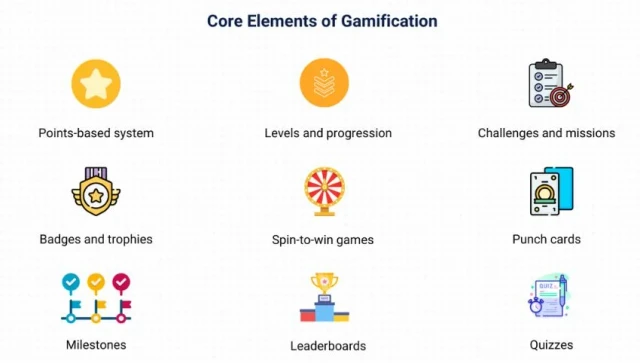
Gamification is a proven strategy to enhance engagement and make experiences more interactive and enjoyable. Experts recommend advanced techniques such as:
- Dynamic Challenges: Use adaptive difficulty to keep users motivated.
- Reward Systems: Offer meaningful rewards like discounts or exclusive content.
- Real-Time Feedback: Recognize achievements instantly with leaderboards or streak counters.
Personalization: Tailoring Experiences for Maximum Relevance
Personalization creates a deeper connection with the audience by catering directly to their needs and preferences. Advanced personalization strategies include:
- AI-Powered Recommendations: Delivers tailored content or products using behavioral algorithms.
- Behavioral Segmentation: Groups users by actions, like engagement or preferences, for personalized experiences.
- Contextual Customization: Adapts content in real-time based on location, time, or interactions.
Social Sharing: Amplifying Reach Through Community Interaction
Social sharing encourages users to broadcast their participation or achievements to a broader audience, enhancing the visibility and impact of your initiative. Advanced tactics include:
- Shareable Achievements: Create milestones or badges users can share on social media.
- Referral Incentives: Reward users for inviting friends with exclusive perks.
- Social Proof: Highlight user content or top participants to boost engagement.
Exclusive Community: Building a Sense of Belonging

Creating an exclusive community fosters loyalty and strengthens user relationships. Strategies for maximizing the impact of such communities include:
- Membership Tiers: Provide exclusive perks for VIPs or early adopters.
- Live Interactions: Host webinars, Q&As, or events for direct engagement.
- Recognition Roles: Highlight members or assign roles like moderators to boost loyalty.
By combining these advanced strategies, you can create a highly impactful experience that not only engages but also retains your audience while extending the reach of your initiatives.
Make Things Easy With Joy Rewards & Loyalty Program
Loyalty programs retain customers, and referral programs bring in new ones. Together, they create a powerful loyalty-referral loop that drives continuous growth. By setting clear goals and using the right tools, these programs can work seamlessly to amplify your online store’s success.
Now, here’s the good news: you don’t have to do it all on your own. Joy – Rewards & Loyalty Program on Shopify makes it easy to create a loyalty-referral program that works for your online store. So, what are you waiting for?
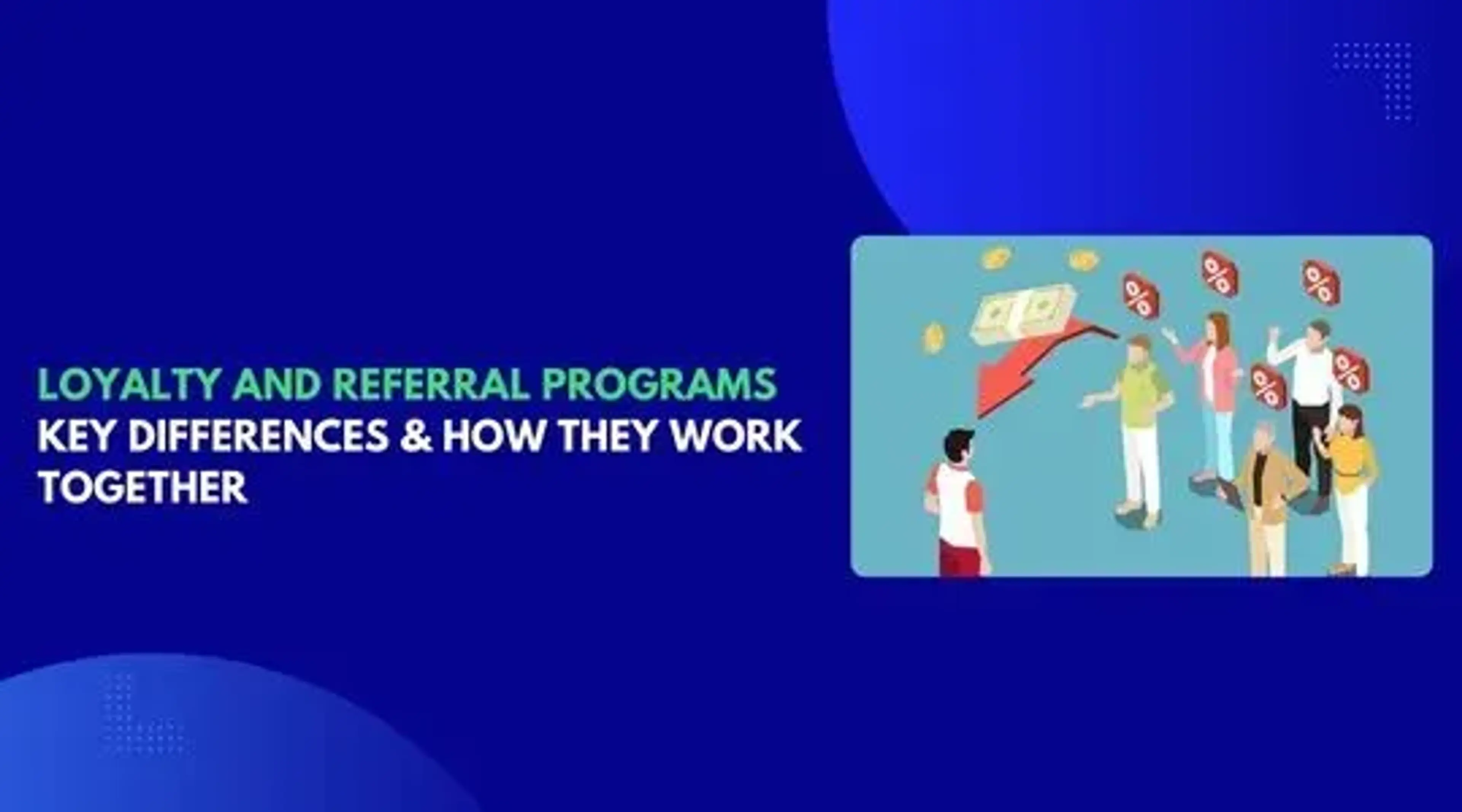


-a7e9a3.png?width=828&q=75&f=webp&auto=format)
